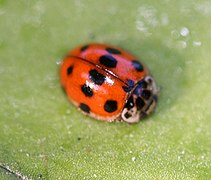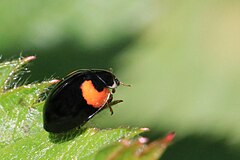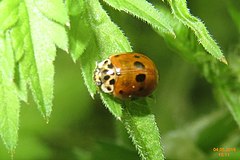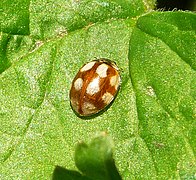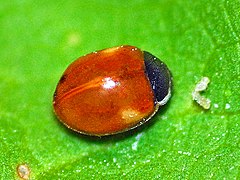
Adalia bipunctata, the two-spot ladybird, two-spotted ladybug or two-spotted lady beetle, is a carnivorous beetle of the family Coccinellidae that is found throughout the holarctic region. It is very common in western and central Europe. It is also native to North America but it has heavily declined in many states and provinces. It is commonly introduced and imported as a biological control agent.
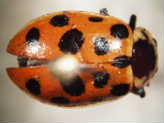
Hippodamia tredecimpunctata, commonly known as the thirteen-spot ladybeetle, is a species of lady beetle.

Coccinella septempunctata, the seven-spot ladybird, is the most common ladybird in Europe. Its elytra are of a red colour, but punctuated with three black spots each, with one further spot being spread over the junction of the two, making a total of seven spots, from which the species derives both its common and scientific names.

Psyllobora vigintiduopunctata, the 22-spot ladybird, is a common, 3–5 mm long ladybird native to Europe . The elytra are yellow in colour with 22 black spots. The pronotum is yellow or white with 5 black spots. Unlike most other ladybirds which feed on aphids, P. 22-punctata eats mildew — especially from umbellifers and low-growing shrubs . The 22-spot ladybird is best looked for amongst low vegetation.

Hippodamia is a genus of ladybirds in the family Coccinellidae. It includes the most common native North American "ladybug", H. convergens, which can form overwintering aggregations numbering in the millions. Another notable member is Hippodamia variegata, which occurs widely over both the North and South Hemispheres.
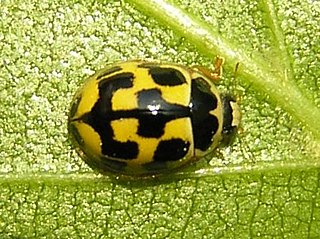
Propylea quatuordecimpunctata is a small lady beetle, belonging to the family Coccinellidae. It is sometimes referred to by the common name 14-spotted ladybird beetle, or simply P-14.

Halyzia sedecimguttata, or orange ladybird, is a species of Coccinellidae (ladybirds) family.

Coccinella undecimpunctata, the eleven-spot ladybird or eleven-spotted lady beetle, it is native to central Asia, though commonly found in Europe, and formerly North America as its populations are decreasing. It is of the family Coccinellidae, commonly referred to as ladybugs or lady beetles.
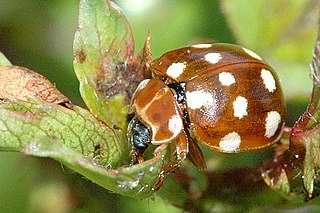
Calvia quatuordecimguttata, the cream-spot ladybird, is a species of ladybird in the family Coccinellidae. Its distribution is holarctic, it being found in Europe and through the East Palearctic to Japan. It is introduced to North America. This ladybird is generally 4 to 5 millimetres in length and varies in appearance depending on the geographical location. It usually lives in hedgerows and deciduous trees.
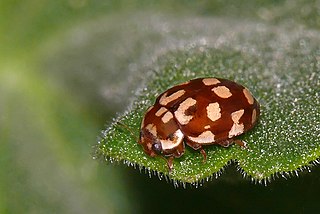
The eighteen-spotted ladybird, or 18-spot ladybird, is a species of beetle in the genus Myrrha in the ladybird family that lives primarily in pine forests and mixed (deciduous/conifer) forests inhabiting the upper part of the canopy and feeding on aphids. They favour old pines and breed in the crowns of pine trees in Germany M. octodecimguttata also occurs on high bogs Adults overwinter in aggregations under peeled-off bark and in crevices at the bases of old pine trunks. It is usually 4 to 5 millimetres in length.
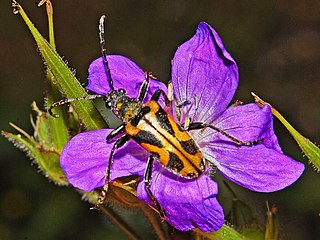
Brachyta interrogationis is the species of the Lepturinae subfamily in long-horned beetle family. This species was described in 1758 by Carl Linnaeus in the 10th edition of Systema Naturae under the name Leptura interrogationis.
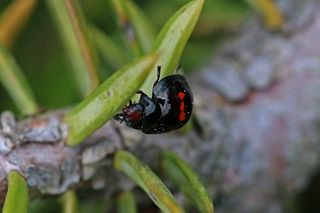
Chilocorus bipustulatus, the heather ladybird, is a beetle species belonging to the family Coccinellidae, subfamily Chilocorinae.

Hippodamia variegata, the Adonis ladybird, also known as the variegated ladybug (US) and spotted amber ladybeetle (Aus), is a species of ladybeetle belonging to the family Coccinellidae, subfamily Coccinellinae.
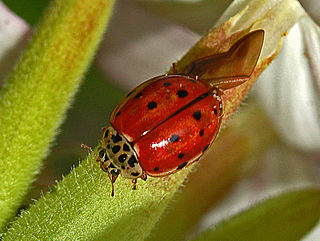
Harmonia quadripunctata, the cream-streaked lady beetle or four-spot ladybird, is a species of ladybird belonging to the family Coccinellidae.

Anatis ocellata, commonly known as the eyed ladybug, is a species of ladybug in the family Coccinellidae. It has black spots on a red background, with each spot surrounded by a yellowish halo. In one color variation, a specimen found in Scotland was reported having the spots fused to form longitudinal lines.
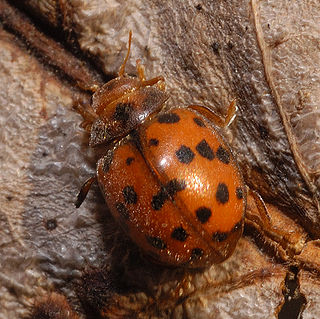
Subcoccinella vigintiquatuorpunctata is a beetle in the family Coccinellidae. It is the only member of the genus Subcoccinella. It has the typical, almost semi-spherical, ladybird shape and is patterned with spots. However it differs from many of the well-known ladybirds in being neither smooth and shiny nor an eater of aphids: the wing-cases look velvety and it eats fungal moulds on plants.

Aphidecta obliterata is a species of Coccinellidae, a flying beetle.

Anisosticta novemdecimpunctata is a species of beetle in family Coccinellidae. It is found in the Palearctic.

Coccinella hieroglyphica is a species of beetle in family Coccinellidae. It is found in the Palearctic. Coccinella hieroglyphica is found in Europe, European Russia, Siberia, the Russian Far East, Belarus, Ukraine, Kazakhstan, Mongolia, China, Korea. In Europe, in the north beyond the Polar circle, in the south to Northern Italy. They live in heath and moorland habitats to heights of 1,200 meters, on different Ericaceae, feeding on aphids. Other, less preferred, habitats are wet meadows, marshes, wastelands, and mixed forests. Other host plants are Pinus abies and other Pinus species and various Betula species. Their populations vary greatly from year to year. They fly from May to October and overwinter in coarse woody debris under pines and birches. In the former USSR, it is aphidophagous on Salix species, birches, and on Alnus and Poaceae

Myzia oblongoguttata, commonly known as the striped ladybird, is a species of beetle in family Coccinellidae. It is found in the Palearctic.


